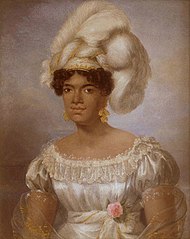| Kamāmalu | |||||
|---|---|---|---|---|---|
 Portrait of Kamāmalu at
ʻIolani Palace | |||||
| Queen consort of the Hawaiian Islands | |||||
| Tenure | May 20, 1819 – July 8, 1824 | ||||
| Born | c. 1802 Kawaihae, Hawaii | ||||
| Died | July 8, 1824 (aged 21–22) London, England | ||||
| Burial | May 11, 1825
[1] | ||||
| Spouse | Kamehameha II | ||||
| |||||
| House | House of Kamehameha | ||||
| Father | Kamehameha I | ||||
| Mother | Queen Kalākua Kaheiheimālie | ||||
Kamāmalu Kalani-Kuaʻana-o-Kamehamalu-Kekūāiwa-o-kalani-Kealiʻi-Hoʻopili-a-Walu ( c. 1802–1824) was Queen consort of the Kingdom of Hawaiʻi as the wife of King Kamehameha II. Kamāmalu was short for Kamehamalu or Kamehamehamalu meaning "the Shade of the Lonely One", honoring her father, "the Lonely One". [2] She is not to be confused with her niece, Princess Victoria Kamāmalu.
Life
She was the eldest daughter of Queen Kalākua Kaheiheimālie and King Kamehameha I. She was referred to as Kekūāiwa for the early part of her life. According to John Papa ʻĪʻī, she was betrothed to her half-brother Kamehameha II from birth and they were married when she was twelve and he was seventeen or eighteen. [3] Her younger sister Kīnaʻu later also became wife of Kamehameha II as did their half-sister Kekauluohi by their mothers Kalakua Kaheiheimalie. Even though her husband had four other wives (two of them her sisters and the two others her nieces), Kamāmalu was her husband's favorite wife.
In 1823, she joined a royal procession honoring her husband's accession to the throne in a car modeled as a whaleboat. It was fastened to a platform 30 feet (9.1 m) long by 12 feet (3.7 m) wide and borne by 70 men. The boat was lined and the whole platform covered with fine imported broadcloth and tapa cloth of rich colors. The only dress of the queen was a scarlet silk paʻū, and a coronet of feathers. She was seated in the middle of the boat, and screened from the sun by an immense Chinese umbrella of scarlet damask, ornamented with gilding and tassels, supported by a chief standing behind her in a scarlet loincloth and feather helmet. On the boat stood Prime Minister Kalanimoku and national orator Naihe in feathered helmets and bearing a kahili or feather staff of state. [4]
Queen Kamāmalu had a tattoo applied to her tongue as an expression of her deep grief when her mother-in-law Queen Keōpūolani died in 1823. Missionary William Ellis watched the procedure, commenting to the queen that she must be undergoing great pain. The queen replied, "He eha nui no, he nui roa ra ku‘u aroha." (Great pain indeed, greater is my affection.) [5]

In 1823, Kamehameha II and Kamāmalu left the Sandwich Islands for London, arriving there in May 1824 for a state visit with King George IV. In London the royal party were fitted with the latest fashion and attended opera and ballet at the Theatre Royal in Drury Lane. [6] Many ladies of London sought the patterns of the turban that adorned her head. She attracted attention because she stood over six feet tall and was strikingly beautiful. She and her husband were the first Hawaiian monarchs to visit England. While in London, Kamāmalu contracted measles and died on July 8. [7] Six days later her grief-stricken husband also died of the measles. Their bodies were placed in coffins and taken back to Hawaii on HMS Blonde. At first they were buried in a coral house on the grounds of the ʻIolani Palace, but were later moved to the Royal Mausoleum in Nuʻuanu Valley of Oʻahu island.
Family tree
References
- ^ Roger G. Rose; Sheila Conant & Eric P. Kjellgren. "Hawaiian standing kahili in the Bishop museum: An ethnological and biological analysis". Journal of the Polynesian Society. Polynesian Society: 273–304. Retrieved 2011-09-18.
- ^ Sarah Josepha Hale (1853). Woman's Record: or, Sketches of All Distinguished Women, from "the Beginning" till A.D. 1850. New York: Harper & Brothers. p. 371.
- ^ Corley 2012, p. 40.
- ^ Charles Samuel Stewart (1828). Residence in the Sandwich Islands. John P. Haven. pp. 92–93.
- ^ William Ellis (1853). Polynesian researches during a residence of nearly eight years in the Society and Sandwich islands. Bohn. p. 181.
- ^ J. Susan Corley (2008). "British Press Greets the King of the Sandwich Islands: Kamehameha II in London, 1824". Hawaiian Journal of History. Vol. 42. Hawaii Historical Society. hdl: 10524/261.
- ^ Stanford T. Shulman; Deborah L. Shulman; Ronald H. Sims (August 2009). "The Tragic 1824 Journey of the Hawaiian King and Queen to London: History of Measles in Hawaii". The Pediatric Infectious Disease Journal. 28 (8): 728–733. doi: 10.1097/INF.0b013e31819c9720. PMID 19633516. S2CID 19374372.
Bibliography
- Corley, J. Susan (2012). "Queen Kamämalu's Place in Hawaiian History". Hawaiian Journal of History. 46. Hawaiian Historical Society: 37–60. hdl: 10524/33793.